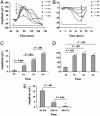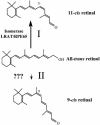Isorhodopsin rather than rhodopsin mediates rod function in RPE65 knock-out mice
- PMID: 14578454
- PMCID: PMC263870
- DOI: 10.1073/pnas.2234461100
Isorhodopsin rather than rhodopsin mediates rod function in RPE65 knock-out mice
Abstract
The chromophore of visual pigments is 11-cis-retinal and, thus, in its absence, opsin is not photosensitive and no visual function exists. However, in the RPE65 knockout (Rpe65-/-) mouse, where synthesis of 11-cis-retinal does not occur, a minimal visual response from rod photoreceptors is obtained. We have examined if an alternative pathway exists for cis-retinoid generation in the absence of RPE65. Cyclic-light-reared, 2-month-old Rpe65-/- mice were placed in complete darkness. No exogenous retinoids were administered. After 4 weeks, enhanced a- and b-wave amplitudes were obtained, increasing >10-fold for the a-wave and >3-fold for the b-wave as compared with cyclic-light-reared Rpe65-/- mice. Visual-pigment levels increased to approximately 10 pmol per retina, compared with no measurable pigment for cyclic-light-reared Rpe65-/- mice. The lambdamax of the isolated pigment was 487 nm, characteristic for isorhodopsin. Retinoid extractions confirmed the presence of 9-cis-retinal and the absence of 11-cis-retinal. Once the Rpe65-/- mice were returned to cyclic light, within 48 h the electroretinogram function returned to levels found in Rpe65-/- mice maintained in cyclic light. This dark-mediated pathway is also operational in older animals, because 13-month-old Rpe65-/- mice kept in prolonged darkness (12 weeks) had increased isorhodopsin levels and electroretinogram a- and b-wave amplitudes. These studies demonstrate that a pathway exists in the eye for the generation of 9-cis-retinal that is independent of RPE65 and light.
Figures





References
-
- Redmond, T. M., Yu, S., Lee, E., Bok, D., Hamasaki, D., Chen, N., Goletz, P., Ma, J. X., Crouch, R. K. & Pfeifer, K. (1998) Nat. Genet. 20, 344-351. - PubMed
-
- Gu, S. M., Thompson, D. A., Srikumari, C. R., Lorenz, B., Finckh, U., Nicoletti, A., Murthy, K. R., Rathmann, M., Kumaramanickavel, G., Denton, M. J. & Gal, A. (1997) Nat. Genet. 17, 194-197. - PubMed
-
- Lorenz, B., Gyurus, P., Preising, M., Bremser, D., Gu, S., Andrassi, M., Gerth, C. & Gal, A. (2000) Invest. Ophthalmol. Visual Sci. 41, 2735-2742. - PubMed
-
- Marlhens, F., Bareil, C., Griffoin, J. M., Zrenner, E., Amalric, P., Eliaou, C., Liu, S. Y., Harris, E., Redmond, T. M., Arnaud, B., et al. (1997) Nat. Genet. 17, 139-141. - PubMed
Publication types
MeSH terms
Substances
Grants and funding
LinkOut - more resources
Full Text Sources
Other Literature Sources
Molecular Biology Databases

